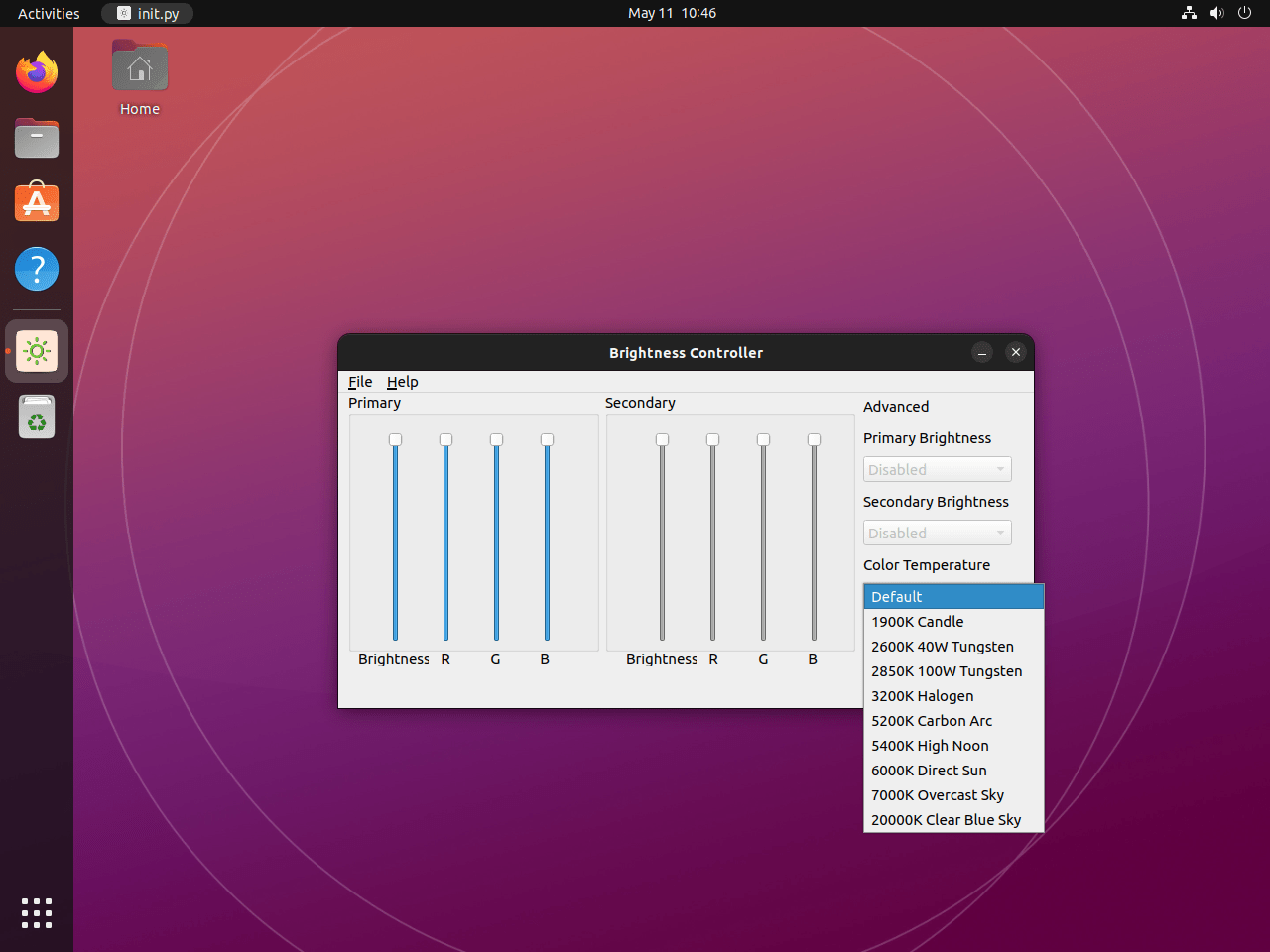Brightness Controller is the go-to solution for managing the brightness of your Ubuntu desktop’s display directly from your command line. This utility tool, designed with user-friendliness in mind, enables precise control over your screen’s brightness and color temperature, making it a must-have for those looking to customize their viewing experience. Whether you’re adjusting for better readability or reducing eye strain during late-night sessions, Brightness Controller offers a straightforward approach to enhancing your desktop environment.
Here are some compelling reasons to use Brightness Controller:
- Ease of Use: Simple command-line inputs for quick adjustments.
- Customization: Tailor your screen’s brightness and color temperature to your liking.
- Compatibility: Supports a wide range of Ubuntu versions.
- Accessibility: Ideal for users with specific visual requirements.
- Efficiency: Helps reduce eye strain and conserve energy.
- Flexibility: Multiple monitor support is available for advanced setups.
- Free and Open Source: Enjoy and contribute to the software freely.
- Community Support: Backed by a responsive and helpful community.
Now, let’s get started with the installation process.
Update Ubuntu System For Brightness Controller Installation
Ensuring that your Ubuntu system is fully up-to-date is crucial to commence the installation process. This will help avoid package conflicts and ensure compatibility with the Brightness Controller software.
To achieve this, we will execute the following commands in the terminal:
sudo apt update && sudo apt upgradeThis command line sequence will first refresh the list of available packages from the Ubuntu repositories (sudo apt update). Following this, the second command (sudo apt upgrade) will upgrade any outdated software packages on your system.
Import Brightness Controller’s PPA
The recommended method for installing Brightness Controller on Ubuntu is to utilize the Personal Package Archive (PPA) maintained by Archisman Panigrahi. PPAs provide a direct channel to obtain software and updates that may not be available in the official Ubuntu repositories.
To add the Brightness Controller’s PPA to your system, input the following command:
sudo add-apt-repository ppa:apandada1/brightness-controller -yUpon successfully adding the PPA, it’s necessary to instruct the system to refresh its package list to incorporate the new repository. This can be achieved by running the ‘apt update’ command again:
sudo apt updateInstall Brightness Controller via APT Command
You can install the Brightness Controller on Ubuntu with the PPA correctly integrated and the package list updated. To do this, enter the following command:
sudo apt install brightness-controllerThis command will instruct the system to install the Brightness Controller package from the newly added PPA.
Initiating Brightness Controller
CLI Method to Launch Brightness Controller Application
Brightness Controller can be started directly from the terminal for those comfortable with the command-line interface. This method provides a quick and efficient way to access the software. Here’s the command you need to execute:
brightness-controllerGUI Method to Launch Brightness Controller Application
Alternatively, Brightness Controller can be accessed through the applications menu using the desktop environment’s Graphical User Interface (GUI). This method allows for a more visual and interactive way of launching the software.
Here’s the navigation path you need to follow:
Activities > Show Applications > Brightness Controller

Additional Commands For Brightness Controller
Update Brightness Controller
Updating your software is essential for accessing new features and improvements and ensuring your system’s security and stability. As an Ubuntu user, the Advanced Package Tool (APT), Ubuntu’s package manager, makes this process easy and efficient.
To update Brightness Controller, along with all other APT-managed software on your system, execute the following command in your terminal:
sudo apt upgrade && sudo apt upgradeThis command first updates the package list (with sudo apt update) and then upgrades all upgradable packages to their latest versions (with sudo apt upgrade). This approach helps maintain your system’s health and ensures you utilize the most recent features and security patches for all your installed software, including Brightness Controller.
Remove Brightness Controller
If you no longer need Brightness Controller, it can be removed from your system using APT. To uninstall the software, run the following command in your terminal:
sudo apt remove brightness-controllerThis command will remove the Brightness Controller software from your Ubuntu Linux system. However, it’s important to note that the Personal Package Archive (PPA) used for installing Brightness Controller will remain in your system’s repository list.
Remove Brightness Controller PPA
Removing the associated PPA is also a good practice if you’re sure you won’t be using Brightness Controller again. This can be done using the following command:
sudo add-apt-repository --remove ppa:apandada1/brightness-controller -yThis command ensures that your system repository list remains clean and organized, containing only the PPAs for the software you intend to use. With these steps, you now possess the knowledge to manage Brightness Controller effectively on your Ubuntu Linux system.
Closing Thoughts
In wrapping up, this guide walked you through the steps to install Brightness Controller on Ubuntu, offering insights into making the most of your screen’s brightness and color temperature. We’ve covered everything from first-time installation tips to customizing your experience for comfort and productivity. Remember, the key to using Brightness Controller effectively lies in gradually finding what works best for you and integrating it into your daily routine.


Thank you very much, here it worked correctly following the steps! helped a lot
I installed brightness-controller, and nothing happens when I adjust the controls. The software is referencing eDP-1.
When I start brightness-controller, I get the following on the console:
QSocketNotifier: Can only be used with threads started with QThread
libEGL warning: egl: failed to create dri2 screen
I am using an HP laptop with nVidia GeForce RTX graphics board running Ubuntu 24.04
Hi Steve,
Thanks for reaching out. Here are a few suggestions to help you with the Brightness Controller issue on your HP laptop running Ubuntu 24.04:
Check Display Output:
Ensure the display output used by your laptop matches the one referenced by Brightness Controller (eDP-1).
Run this command to list connected displays:
xrandr --listmonitorsIf the output is different, update the display reference in the Brightness Controller settings.
QSocketNotifier:
Can only be used with threads started with QThread:
This error is related to threading issues in Qt. Unfortunately, this is a bug within the software that may require an update or patch from the developers of Brightness Controller. In the meantime, you can try running Brightness Controller with root privileges to see if it mitigates the issue:
sudo brightness-controllerDependencies:
Ensure that all necessary dependencies for Brightness Controller are installed. You can install common dependencies with the following commands:
sudo apt install python3-pipsudo pip3 install brightness-controller
sudo apt install qt5-default pyqt5-dev pyqt5-dev-tools
sudo apt install libegl1-mesa libegl1
Hope this helps!
Best regards,
Joshua James